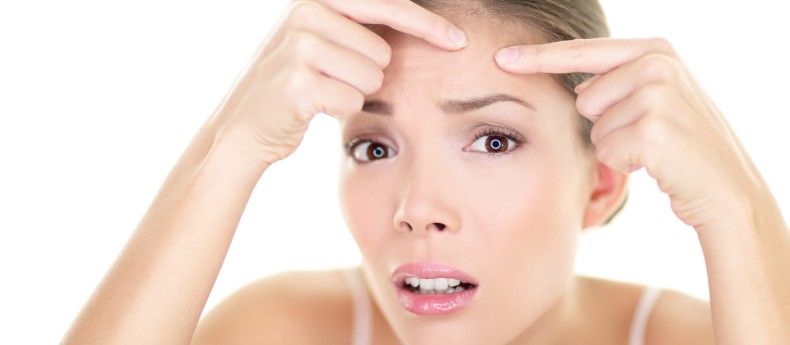
Acne and Pimples and Zits! Oh My!
Commonly known as pimples or zits, acne is dermatological concern for all age groups. Teenagers tend to face the biggest risk of developing acne, but many adults, infants and young children sprout pimples as well. Acne can be a source of great distress and may even trigger depression. In this article, I will introduce the reader to the basics of acne treatment and prevention in hopes of demystifying this annoying skin ailment.
What is acne?
Acne is an inflammation of the sebaceous glands, which are located at the base of the hair follicles peppered all over the body. Under normal circumstances, the sebaceous glands secrete sebum, an oily secretion that travels along the hair follicles to surface of the skin. When excess sebum is secreted, it can plug up the sebaceous gland, which could combine with a bacterial infection to result in inflammation. This, then, results in what we call acne.
What causes acne?
Acne is caused by a variety of factors, the primary one being an excess of sebum. Excessive secretion of sebum correlates with the presence of what are typically known as “male hormones.” For example, people suffering from polycystic ovary syndrome due to an excess of ovarian androgen also tend to have more acne. These people can control their symptoms by taking oral contraceptives. Note: For people with acne that does not result from polycystic ovary syndrome, contraceptives will not be an effective acne treatment. Additionally, males and females produce a lot of testosterone during puberty. Increased testosterone levels lead to an increase in sebum. Therefore, teenagers are quite prone to acne, especially if they’re male.
Under the influence of “male hormones,” when sebum is in excess and certain fatty acids unavailable to the cells in hair follicles, a second factor contributes to the formation of acne: keratinization (build-up of excess skin cells) in the hair follicle. When skin cells are shed, build up in the hair follicle and mix with clogged sebum, acne forms.
The third factor in the formation of acne is bacteria. When hair follicles are blocked, the inside of the hair follicles becomes an oxygen-deficient environment, perfect for bacteria to thrive and for the rapid production of free fatty acids. These free fatty acids can cause inflammation of hair follicles and reactions in the surrounding skin. At their most extreme, bacteria and fatty acids have caused severe abscesses and pustules.
In addition to these three main factors, genetics, drugs and environmental factors also affect the incidence and duration of acne. Having one or both parents with a history of acne issues could mean that you develop acne more easily than others and experience more severe symptoms. Living/working for long periods of time in a heavily polluted environment can cause acne by clogging hair follicles. Neglecting your skin, compromising your physical health, and frequently using cosmetics (e.g., foundations) that are more silty and oily could also plug up your hair follicles. Women are more likely to develop acne during the two weeks before each menstruation cycle, when hormone levels peak and sebum secretion rates increase. Generally speaking, acne in adults is usually brought on by stress-related factors: work fatigue, pressure, inadequate rest, endocrine (hormonal) imbalances caused by psychological tension or excitement. Urbanites beware: all of these factors can continue to exacerbate production of “male hormones,” inducing or aggravating acne.
Symptoms of acne
Acne vulgaris is the most common type of acne. What we normally call “whiteheads” are evidence of early-stage acne. When excess melanin collects in a plugged hair follicle, it forms a blackhead. When people squeeze these types of pimples, the fat deposits underneath get pushed to the surface. If the inflammation gets worse, the area around it turns red and form what we know as pimples and pustules. If not treated, the inflammation develops into something more dramatic, such as the formation of red bumps of varying sizes or cysts. When several of these bumps or cysts clump together, the condition is called acne conglobata.
Reactions to and clinical manifestations of acne vary between individuals. For most patients, acne symptoms reduce or disappear within the year of onset. For others, abscesses or cysts can form if symptoms are resistant to treatment; in these cases, depressions in the skin and scars will likely form.
Acne prevention and treatment
Acne prevention integrates internal and external efforts. Bacterial growth should be inhibited from the outside, and hormonal balance should be achieved on the inside. You can practice good daily skin care habits as well: Pay attention to your skin (dryness, oiliness, color, etc.), use a non-irritating facial cleanser, avoid touching your face with dirty hands. More general than skin care, you can prevent acne by establishing a healthy lifestyle: engage in healthy activities that give you joy, find appropriate avenues for stress relief, eat a healthy diet (consuming less alcohol and spicy foods and smoking less will help you avoid vasodilation; dilated blood vessels induced and aggravate acne).
Acne treatments include oral and topical treatments. The first steps are always to clear any obstructed hair follicles or skin pores so that sebum can escape. Oral and topical antibiotics inhibit inflammation on the skin. For example, Vitamin A acid drugs can directly or indirectly affect several factors causing acne, thus influencing sebaceous gland function, keratinization and bacterial growth within sebaceous ducts and hair follicles, and inflammation.
A word of caution: Because the onset and duration of acne is so uncertain, many people choose to control their acne by taking birth control pills or blindly using hormone therapies. Applying these treatments without consulting a dermatologist or doctor can potentially lead to a worsening of your symptoms and/or serious side effects. Although most people’s acne symptoms gradually subside on their own, I would recommend that you consult a professional dermatologist if you are concerned about your acne (or any other skin condition). Early diagnosis and regular treatments are the best way to effect a cure. Acne treatments must be prescribed to address the cause of the acne. No single treatment would be appropriate for all cases of acne. Additionally, it is important to resist the temptation to squeeze your pimples. Some people think that the acne could be eradicated by a clean squeeze and that releasing the pus helps to detoxify the skin. This is a gross misunderstanding (pardon the pun). While you may be releasing pus from your pores, you are also simultaneously pushing bacteria in the opposite direction, deeper into the hair follicle. This action will leave not only scars but also encourage inflammation.
Regardless whether you have acne, a balanced lifestyle and healthy eating habits achieve a positive effect on the skin in general. And when skin conditions to beset you, please consult a professional dermatologist promptly for diagnosis and treatment. Whatever you do, do not squeeze your pimples with your hands or blind take dermatological advice.






